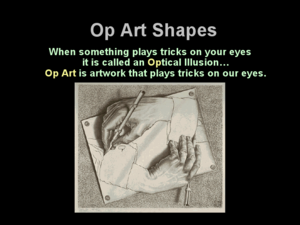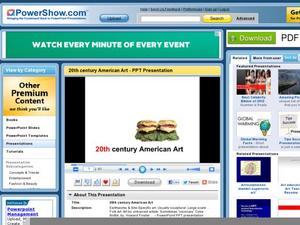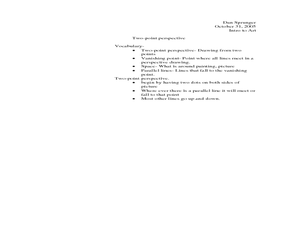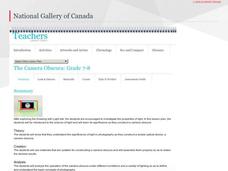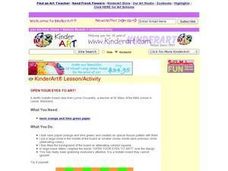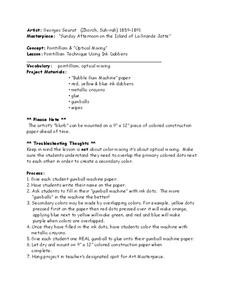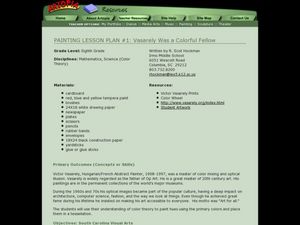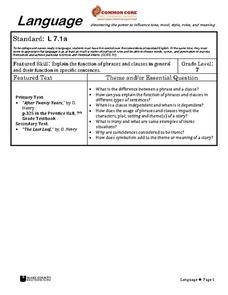K12 Reader
The Art of M.C. Escher
Show your class one way in which art and math are related by teaching them about M.C. Escher. Class members read a brief passage and then respond to five related questions.
Curated OER
Op Art Shapes
Op art is fun to look at, and it's fun to make. Kids learn about the origins of op art and the op art master, M.C. Escher. They view simple to complex examples of op art to see how it works and then create an optical piece of their own....
Curated OER
20th Century American Art
See the changes, controversy, and innovations that define postwar American art. The onset of the modern art era in American history is well-defined in this slide-show. You'll see how Abstract Expressionism shifted into conceptual, pop,...
University of Minnesota
Beautiful Brain: Do You See What I See?
Can art play tricks on your eyes, and can a still painting really appear to vibrate? The second lesson in a four-part series discusses the way our beautiful brains translate visual images. It highlights the style of optical art and...
Curated OER
Art History Choice Board
Art History students are offered a menu of project choices designed especially for their learning style. Logical/mathematical learners research the Op Art period and create their own optical illusion. Interpersonal learners work in pairs...
Curated OER
Geometric Optic Spinner
Students investigate the concept of an optical illusion and how they are used. They conduct an information search of how the eye works. The information is used in order to set the context upon the creation of a personal optical illusion.
Curated OER
Intro to Art
Students explore illusions by drawing and viewing images in class. In this art perspective lesson, students analyze a skeleton outline drawing which demonstrates the ability to draw in a two point perspective. Students utilize the...
Curated OER
Exploring Optical Movement in Art
Students describe, represent and analyze patterns and relationships using shapes. They create simple geometric patterns. They demonstrate increasing technical ability and skill to complete visual arts assignments.
National Gallery of Canada
Mastering One-Point Perspective
Cover one-point perspective through observation and practice. Class members examine several works of art that use one-point perspective, look at magazine images to find the vanishing points and horizon lines, and draw their own city...
Curated OER
Op Art Circles
Students create Optical Art, art that seems to move when you look at it, in this Art lesson for the High School classroom. Included with the lesson is a list of recommended materials and suggested resource books for lesson implementation.
Curated OER
Op Art and Contrast
Seventh graders create Op art designs by reading web information through FlingIt, mapping learned concepts with PicoMap, and creating how-to examples of their own Op art design by using Sketchy. They complete the lesson by creating their...
National Gallery of Canada
The Camera Obscura
You can create a camera with even the most unassuming materials. Learners view photographs and talk about the art. Some background information is included about the camera obscura for you to present before individuals make their own...
Curated OER
Optical Illusion Vase
Students draw an optical illusion. In this optical illusion lesson plan, students create the optical illusion vase. Students draw a profile and repeat the drawing in reverse creating the vase image.
Curated OER
Op Art and Contrast
Seventh graders explore the Op art movement and the work of artists Bridget Riley, Victor Vasarely and MC Escher. the principles of contrast and how it can be used to create optical illusions is examined in this lesson.
Art Institute of Chicago
Color Combinations
Explore color through an examination of pointillism and light. Class members view Georges Seraut's famous painting on a computer, zooming in and out to see the details and effects of the technique. They then cover how light and color are...
Curated OER
Open Your Eyes To Art!
Students help create a colorful bulletin board for classroom art displays in this short lesson for the early elementary classroom. The lesson, which can use a variety of items, includes product ideas and resource links to find very...
Curated OER
Art One-Master Emulation Acrylic Painting Lesson Plan
Students examine art history books and gather information on three masters. Using the text, they gather information about their history, style, and the techniques they used. They create their own paintings using acrylic paint using the...
Curated OER
Pointillism Technique Using Ink Dabbers
A gumball machine art project is a great way to learn about optical mixing in a study of pointillism and Georges Seurat. Kids create their own masterpieces and learn about primary and secondary colors in the process.
National Gallery of Canada
My Upside-Down World!
M.C. Escher is famous for creating optical illusions. Examine this effect in several of his works and discuss the techniques involved. Inspired by the discussion, learners create an imaginary 3-D world inside of a box using various...
Curated OER
Psychedelic Checkerboard Op Art
Learners analyze optical illusions from the packets, both individually and as a class. They create an original optical illusion design using pattern and repetition. They determine which color needs to be in the pattern.
Curated OER
Vasarely Was A Colorful Fellow
Eighth graders create artwork inspired by the work of Victor Vasarely. In this op art lesson, 8th graders explore color theory and color mixing. Students create ten shapes to use in their artwork and over the course of two weeks,...
Wake County Public Schools
Language
Have your class doing everything from reading literature, analyzing literary devices, identifying independent and dependent clauses, discussing, and writing creatively with the rich resource found here. After a mini lesson on independent...
Curated OER
The Sky Show
Learners use the internet to gather information to create their own science lesson plan. They choose from optical, wind, or electrical phenomena and use the internet to research information. Finally, they organize the information they...
Curated OER
Warm Sun And Cool Moon
Discover the art and art techniques of George Seurat (1859-1891). Your class will create their own multimedia examples of visual art in this Art lesson for the 3rd and 4th grades. The lesson includes a short vocabulary list and...
Other popular searches
- Art Optical Illusions
- Optical Art Media
- Optical Art Powerpoint
- Optical Art Lessons
- Optical Art Lessons Primary
- Optical Illusion Art Lesson



